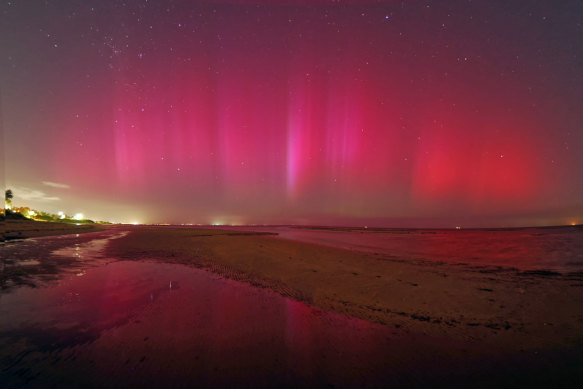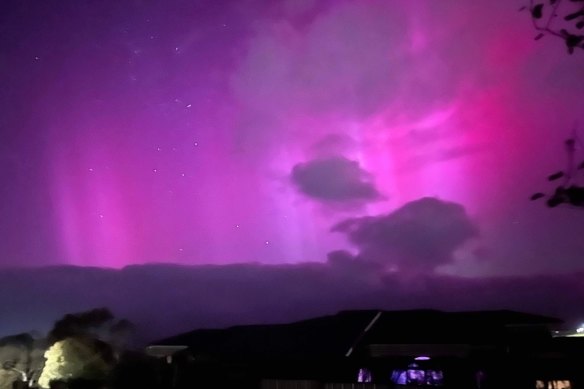The prime spots for a chance to see the rare aurora
If you head outside on Friday tonight – and if the weather is kind – there’s a chance you’ll be treated to a vibrant aurora in the night sky.

It’s a big if. Meteorologists are forecasting cloudy conditions over Melbourne, but there’s a reasonable chance they’ll clear briefly and let the dazzling spectacle in.
The dancing ribbons of red and green seem serene and majestic, but are actually telling a story of extreme conditions far from our planet.
Auroras can typically only be seen in the very far north and south of our planet. But a recent period of extreme solar activity has meant so many charged particles are striking our atmosphere that the colourful shows have been seen as far north as Sydney. Earlier this year, brilliant hues of pink, green and purple lit up the sky as the aurora australis – also known as the southern lights – performed its dance.
To see it, you just need to wait for nightfall – and for the clouds to clear.
“It can be seen all through the night,” says Dr Sara Webb, an astronomer based at Swinburne University. “This will look like ribbons of dancing light, greens and reds.”
The aurora seen at Rickett’s Point on Friday morning.Credit: Peter Hammer
The view will be even better from regional Victoria, where clear skies are forecast. Sydney faces the prospect of rain, unfortunately. The best viewing will be in areas with low light pollution, letting the colours really stand out. It’s possible they may be visible on Saturday night, too.

“Just north of Geelong, around Ballarat, Meredith, we could see clear skies – so we could potentially observe the aurora,” says Weatherzone meteorologist Maryam Al-Ansari.
The physics that cause auroras originate at our nearest star. To understand why, we need to understand the sun’s own unusual physics.
Loading
Every 11 years, roughly, the sun’s magnetic field flips. If you were on the surface and holding a compass, you’d see north and south instantly switch places. That event is preceded by a dramatic increase in solar activity, known as the solar maximum.
As the sun moves towards solar maximum and grows more energetic, its magnetic fields become more strained. Some can twist and snag on each other.
Eventually, as the sun’s power grows, these “field lines” can break and reconnect, says Webb. When they do, they release a huge charge of energy and charged particles from the sun’s surface, which fly toward the Earth.
The Earth is protected by a relatively stable magnetic field. It shields us and our atmosphere from the sun’s stream of charged particles. Without it, we’d have no atmosphere and life could not exist.
On Friday night the field will again do its job and deflect nearly all the charged particles from the sun, but a few will sneak through.
Morning skies over Warnambool on Friday morning with magnificent aurora displays in pink and red.Credit: Madalaine Burke/Nine News
When they do, they will strike and excite electrons in the atoms of oxygen and nitrogen in the atmosphere. As those atoms release that energy, they will glow red and green – giving us the spectacular night show of the aurora.
Importantly, so long as the sky is clear, the aurora should be there – even if you can’t see it with the naked eye.
Loading

























































